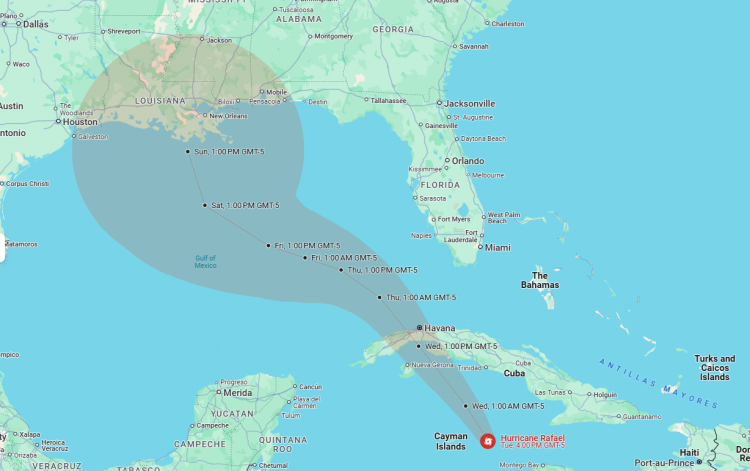Hurricane Rafael, an unusually late-season storm, intensified to a Category 1 hurricane as it churned through the western Caribbean, raising concerns along the U.S. Gulf Coast. Meteorologists are closely watching Rafael, which threatens to bring dangerous weather conditions, including strong winds, heavy rains, and storm surges, to Cuba, the Cayman Islands, and potentially the southern U.S. this weekend. The National Hurricane Center (NHC) forecasts the storm will hit Cuba by midweek before potentially reaching the Gulf Coast, though Rafael's exact trajectory remains unclear.
As of Tuesday evening, the storm had strengthened with sustained winds reaching 75 mph, according to the National Oceanic and Atmospheric Administration (NOAA). Rafael is expected to intensify further before making landfall on Cuba's western coast by Wednesday, where "dangerous storm surge and destructive waves are expected," the NHC said. Residents in Cuba's provinces of Pinar del Rio, Artemisa, La Habana, and surrounding areas are on high alert, and schools and government buildings have been shuttered in anticipation. Meanwhile, the U.S. State Department has advised Americans in Cuba to consider leaving, providing flights for those wishing to depart ahead of the storm's arrival.
In its current path, Rafael could make U.S. landfall along the Gulf Coast, from the Florida Panhandle to eastern Texas, by the weekend. Though projections suggest Rafael may weaken before reaching the U.S., the storm's intensity and exact landfall location remain uncertain. Meteorologists indicate it could impact areas as far east as Florida and as far west as the Texas-Louisiana border.
Despite the uncertainty, Dr. Ryan Truchelut, chief meteorologist at WeatherTiger, remarked, "The good news is that Rafael is unlikely to reach the Gulf Coast as a hurricane, though we may still see intense rainfall and rough seas." Dr. Truchelut added that coastal areas, particularly Louisiana, should prepare for beach erosion, dangerous surf conditions, and potential flooding. The storm is also expected to push a surge of tropical moisture, increasing the risk of flash flooding in parts of the southeastern U.S. later this week.
Two separate forecast models have presented contrasting paths for the storm, adding to the uncertainty of Rafael's future trajectory. One model suggests Rafael will steer northward, impacting the eastern Gulf Coast, while another shows a potential westward shift toward northeastern Mexico. This divergence in forecasts underscores the challenges in accurately predicting Rafael's behavior, particularly as atmospheric conditions steer the storm through the Gulf of Mexico.
Rafael, the 17th named storm of an active 2024 Atlantic hurricane season, has already caused damage and significant disruptions in the Caribbean. In Jamaica, tropical-storm-force winds battered parts of the island Tuesday morning, while dangerous conditions prevailed in the Cayman Islands as the storm intensified. Local authorities warned of potential storm surge and flash flooding, with rainfall totals ranging from 3 to 6 inches in some areas. Heavy downpours raised the risk of mudslides, especially in Jamaica's mountainous regions, where local officials closed schools as a precaution.
Cuba, poised to face the brunt of Rafael's power on Wednesday, is expected to experience storm surges reaching up to nine feet in coastal areas, compounded by waves and flooding rain. With sustained winds, the hurricane will likely cause significant damage along its path through the island.
As Rafael advances, the Gulf Coast should prepare for a volatile weather system capable of bringing heavy rains and flooding to vulnerable regions. In a statement, the NHC noted, "It is too soon to determine what, if any, impacts Rafael could bring to portions of the northern Gulf Coast," but residents are urged to monitor forecasts as conditions can evolve rapidly.






